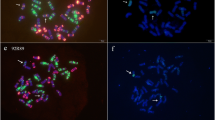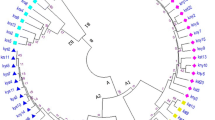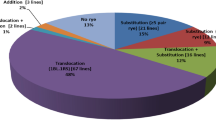Abstract
Underutilized hulled wheat species may be valuable sources of genes for wheat improvement. Hulled wheats of mountainous Central Zagros area of Iran are poorly studied with unclear classification status. In this study, the region was extensively searched and hulled wheats were sampled from local farmers’ fields. Cytogenetic studies of several samples revealed that these wheats are tetraploid with a chromosome number of 2n = 28. Considerable level of karyotypic resemblance was detected between these hulled wheats and durum wheat genotypes, suggesting their genomic similarity. To compare the degree of cross compatibility, F1 progenies were produced using three durum accessions and a bread wheat cultivar as female parent in crosses with two of the collected hulled wheat samples, namely Zarneh and Jonghan. The highest crossability rate was observed when Aria, a durum wheat cultivar, was used as female parent. In general, Jonghan showed higher crossability rate with both bread and durum cultivars as compared to Zarneh. The meiotic behavior of F1 genotypes was analyzed to determine genomic characteristics of hulled wheat samples. Microscopic examination of pollen mother cells at meiotic metaphase strongly suggested the AABB type genome for the hulled wheat samples. Meiotic behaviors of hybrids derived from cross with Zarneh as male parent showed more abnormalities than the other male parent. Meiotic restitution, chromosomes laggards and chromosomal bridges were noticed and the extent varied for each cross. It may be concluded that the hulled wheats of Central Zagros that are currently cultivated are mainly tetraploids emmer containing AABB genome and are crossable with durum wheat, producing hybrids mostly with normal meiotic behaviors.


Similar content being viewed by others
References
Anamthawat-Jonson K, Bodvarsdottir SK (1998) Meiosis of wheat × lymegrass hybrids. Chromosome Res 6:339–343
Andrews AC (1964) The genetic origin of spelt and related wheats. Der Züchter 34:17–22. doi:10.1007/BF00712097
Blanco A, Giorgi B, Perrino R, Simeone R (1990) Risorse genetiche e miglioramento della qualita` del frumentoduro. Agric Ric 114:41–58
D’Antuono LF (1989) Il farro: areali di coltivazione, caratteristiche agronomiche, utilizzazione e prospettivecolturali. L’Informatore Agrario 24:49–51
De Vita P, Riefolo C, Codianni P, Cattivelli L, Fares C (2006) Agronomic and qualitative traits of T. turgidum ssp dicoccum genotypes cultivated in Italy. Euphytica 150:195–205
Dellaporta SL, Wood J, Hick JB (1983) A plant DNA mini-preparation: version II. Plant Mol Biol Rep 1:19–21
Ehsanzadeh P, Sabagh Nekoonam M, Nouri Azhar J, Pourhadian H, Shaydaee S (2009) Growth, chlorophyll, and cation concentration of tetraploid wheat on a solution high in sodium chloride salt: hulled versus free-threshing genotypes. J Plant Nutr 32:58–70. doi:10.1080/01904160802531019
Gandiljan PA (1974) Experimental data on the secondary origin of certain species of the genus Triticum. Biol Žurn Armenii 27:58–65
Hammer K, Filatenko AA, Pistrick K (2011) Taxonomic remarks on Triticum L. and × Triticosecale Wittm. Genet Resour Crop Evol 58:3–10. doi:10.1007/s10722-010-9590-4
Hanelt P (2001) Triticum L. In: Hanelt P, Institute of Plant Genetics and Crop Plant Research (eds) Mansfeld’s encyclopedia of agricultural and horticultural crops, vol 5. Springer, Heidelberg, pp 2565–2591
Harushima Y, Kurata N, Yano M, Sasaki T, Minobe Y, Nakagahra M (1996) Detection of segregation distortion in indica japonica rice cross using a high-resolution molecular map. Theor Appl Genet 92:145–150
Khoshbakht K, Hammer K (2010) Threatened crop species diversity. Shahid Beheshti University Press, Tehran
Kuckuck H (1959) On the findings of Triticum spelta L. in Iran and on the arising of Triticum aestivum-types through crossing of different spelta-types. Wheat Inf Serv, Japan
Lachman J, Musilová J, Kotíková Z, Hejtmánková K, Orsák M, Přibyl J (2012) Spring, einkorn and emmer wheat species––potential rich sources of free ferulic acid and other phenolic compounds. Plant Soil Environ 58:347–353
Maan SS (1973) Cytoplasmic and cytogenetic relationship among tetraploid Triticum species. Euphytica 22:287–300
Moseman JG, Nevo E, GerechterAmitai ZK, Zohary MA (1985) Resistance of Triticum dicoccoides collected in Israel to infection with Puccinia recondite tritici. Crop Sci 25:262–265
Nesbitt M, Samuel D (1995) From staple crop to extinction? The archeology and history of the hulled wheats. In hulled wheats. In: Padulosi S, Hammer AK, Heller J (eds) Proceeding of the 6th International Workshop on Hulled Wheats, International Plant Genetic Resources Institute, Rome, Tuskany, Italy, pp 41–100
Nevo E (1983) Genetic resources of wild emmer wheat: structure, evolution and application in breeding. In: Sakamoto S (ed) Proceeding of the 6th Int Wheat Genet Symp, Kyoto University Press, Kyoto, Japan, pp 421–43
Nevo E (1989) Genetic resources of wild emmer wheat revisited: Genetic evolution, conservation and utilization. In: Miller TE, Koebner RMD (eds) Proceeding of the 7th Int Wheat Genet Symp, Cambridge, UK, pp 121–126
Nevo E (1995) Genetic resources of wild emmer, Triticum dicoccoides, for wheat improvement. News and Views. In: Li ZS, Xin ZY (eds) Proceeding of the 8th Int Wheat Genet Symp, China Agricultural Scientech Press, pp 79–87
Ozkan H, Brandolini A, Schafer-Pregl R, Salamini F (2002) AFLP analysis of a collection of tetraploid wheats indicates the origin of emmer hard wheat domestication in southeast Turkey. Mol Biol Evol 19:1797–1801
Pagnotta MA, Mondini L, Atallah MF (2005) Morphological and molecular characterization of Italian emmer wheat accessions. Euphytica 146:29–37. doi:10.1007/s10681-005-8607-0
Pagnotta MA, Mondini L, Codianni P, Fares C (2009) Agronomical, quality, and molecular characterization of twenty Italian emmer wheat (Triticum dicoccon) accessions. Genet Resour Crop Evol 56:299–310. doi:10.1007/s10722-008-9364-4
Quisenberry KS, Reitz LP (1967) Wheat and wheat improvement. American Society of Agronomy, INC
Riesen T, Winzele H, Ruegger A, Fried PM (1986) The effect of glumes on fungal infection of germinating seed of spelt (Triticum spelta) in comparison to wheat (Triticum aesitvum). J Phytopathology 115:318–324
Riley R, Chapman V (1958) The production and phenotypes of wheat–rye chromosome addition lines. Heredity 12:301–315
Roder M, Korzun V, Wendehake K, Plaschke J, Tixier MH, Leroy P, Ganal MW (1998) A microsatellite map of wheat. Genetics 149:2007–2023
Ruegger A, Winzeler H, Nosberger J (1990) Studies on germination behavior of spelt (Triticum spelta) and wheat (Triticum aesitvum) under stress conditions. Seed Sci and Technol 18:311–320
Schmid JE, Rimle R, Beglinger CH, Winzeler H, Ruegger A, Stamp P (1996) Agronomic and genetic studies with spelt and wheat × spelt crosses. In: Stolen O, Bruhn K, Pithan K, Hill J (eds) Small grain cereals and Pseudo-cereals Workshop, Copenhagen, Denmark, pp 9–18
Stallknecht GF, Gilbertson KM, Ranney JE (1996) Alternative wheat cereals as food grain: Einkorn, emmer, spelt, kamut and triticale. In: Janick J (ed) Progress in new crops. ASHS Press, Alexandria, pp 156–170
Taylor D, Ingvarsson P (2003) Common features of segregation distortion in plants and animals. Genetica 117:27–35
Xie W, Nevo E (2008) Wild emmer: genetic resources, gene mapping and potential for wheat improvement. Euphytica 164:603–614. doi:10.1007/s10681-008-9703-8
Acknowledgments
The authors thank Dr. M.R. Sabzalian for his valuable comments on the manuscript. The authors are further indebted to the Isfahan University of Technology for the financial support given to this research.
Author information
Authors and Affiliations
Corresponding author
Rights and permissions
About this article
Cite this article
Sheibanirad, A., Mirlohi, A., Mohammadi, R. et al. Cytogenetic and crossability studies in hulled wheat collected from Central Zagros in Iran. Plant Syst Evol 300, 1895–1901 (2014). https://doi.org/10.1007/s00606-014-1015-y
Received:
Accepted:
Published:
Issue Date:
DOI: https://doi.org/10.1007/s00606-014-1015-y




